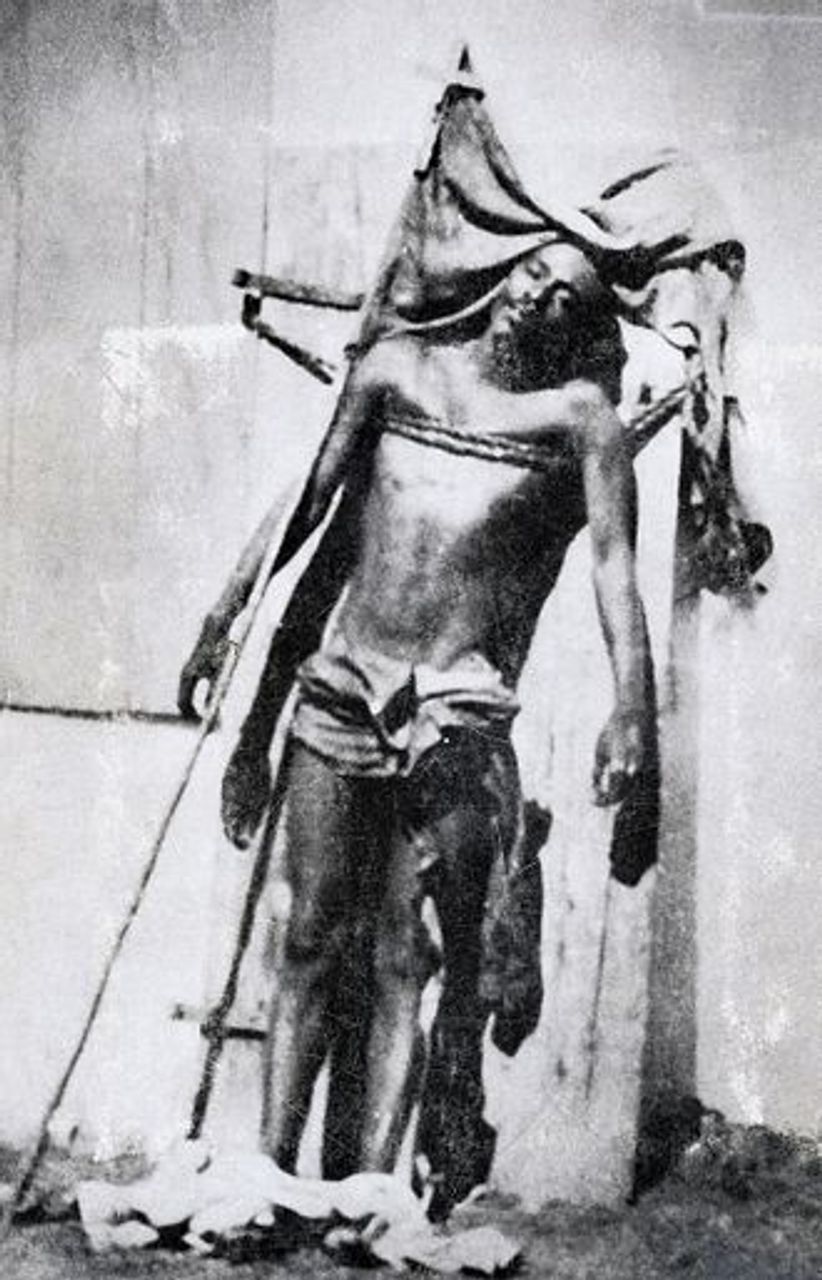In a now-legendary photograph, he appears nailed to a door, the Haitian flag draped over his head. In 1919, the American marines thought they could break the rebellion by displaying his body. Instead, they created a hero. Charlemagne Péralte, leader of the Cacos, remains in Haitian memory as a martyr of national sovereignty and one of the greatest symbols of Black dignity in the face of empire.
Charlemagne Péralte: The Crucified of Haiti, Symbol of Resistance Against the American Occupation (1915–1934)

November 1919. On the walls of Port-au-Prince, an image circulates in secret. The body of a man, tied to a door, arms outstretched in the form of a cross, the Haitian flag draped over his shoulders. His name is Charlemagne Péralte. A former officer of the national army turned insurgent, he has fallen to the bullets of American marines. The occupiers wished to make an example. They made a martyr.
Beneath this photograph of a Black Christ crucified by empire, the very memory of Haiti rose up. For by resisting the American occupation (1915–1934), Péralte restored flesh and spirit to a nation that others sought to subdue. How did a provincial officer from a family of local notables become the face of Haitian dignity?
Charlemagne Masséna Péralte was born on October 10, 1885, in Hinche, a small town on the Central Plateau. His father, the town’s mayor, belonged to the small Black provincial bourgeoisie. His mother, a devout woman, instilled discipline and faith. At the Saint-Louis de Gonzague school, he studied Latin, the humanities, and the history of the heroes of independence. He grew up in a country searching for itself: generals rose and fell in rapid succession, and coups d’état marked the passing of the seasons.
When he entered the army, Péralte was a brilliant and austere young man. At twenty-five, he commanded a garrison in Léogâne. He was described as patriotic, incorruptible, “without fear and without reproach.” The urban elite—often submissive to France or America—viewed him with condescending suspicion: a country officer, too proud, too rigid.
But the year 1915 changed everything.
On July 28, 1915, after the assassination of President Vilbrun Guillaume Sam, American marines landed in Port-au-Prince. Officially, they came to “restore order.” In reality, they came to take control of Haiti’s finances and customs. Haiti became an unspoken protectorate of Washington.
A new president, Philippe Sudre Dartiguenave, was installed by the American ambassador. Local generals were disarmed, public funds placed under foreign control. In 1917, a new Constitution—written under the supervision of the future U.S. President Franklin D. Roosevelt—authorized white foreigners to own land in Haiti for the first time.
In the countryside, resentment grew. Peasants were forced into road-building labor. The marines treated Haitians like rightless “natives.” Racism became system.
It is in this context that the humiliated officer Charlemagne Péralte entered into resistance.
Péralte refused to serve in the gendarmerie, now commanded by Americans. Arrested for insubordination, he escaped from prison and returned to his native Hinche. There he found dispossessed peasants, beaten day laborers, and former soldiers left without pay. He organized them. They became the Cacos, named after earlier mountain guerrillas.
“We do not want war,” he wrote in an underground leaflet. “We want Haiti for Haitians.”
By 1918, he had formed a genuine popular army. His men knew the forests, the rivers, the night roads. With few weapons but immense resolve, they attacked gendarmerie posts, disrupted convoys, and freed prisoners. The Cacos did not fight for power, but for land.
From 1918 to 1919, the rebellion spread from the Central Plateau to the northern mountains. Villages rallied to Péralte. He founded a provisional revolutionary government, minted symbolic currency, and appointed “generals” from among the peasants.
The Americans responded with terror. For the first time in the Caribbean, they used military aviation against Black insurgents. Marine Corps reports mention “cleansed zones.” Entire villages were burned, inhabitants executed. Washington spoke of “rural banditry”; Haitians spoke of a war of liberation.
In the hills of Mirebalais and Grande-Rivière-du-Nord, the Cacos fought fiercely. Their motto: Liberty or death.
Péralte, a skillful strategist, avoided large battles. He struck, vanished, reappeared elsewhere. He became a ghost, a symbol. “The Americans have the airplanes, we have the night,” he told his men.
But empire knows how to corrupt. On October 31, 1919, a Haitian gendarme named Jean-Baptiste Conzé infiltrated Péralte’s camp. In the night, he betrayed him. The marines surrounded the encampment. A gunshot. Péralte fell, shot through the heart.
The next day, his body was displayed. The American soldiers fastened him to a wooden door, arms spread, the national flag across his chest. A photograph was taken and circulated as a trophy.
But instead of extinguishing the revolt, the image sustained it. In the countryside, people discovered a new Black Christ. Mothers hid the image in trunks. Priests slipped it beneath crucifixes. The martyr replaced the “bandit.”
After his death, one of his lieutenants, Benoît Batraville, continued the struggle. For another year, he harassed the marines, before being killed in 1920. The peasant uprising subsided, but the idea of independence was reborn.
When American troops left Haiti in 1934, Péralte’s name rose again as a rallying cry. His remains were exhumed and buried with honors in Cap-Haïtien. President Sténio Vincent paid tribute:
“He was the purest of patriots.”
Historians, beginning with Roger Gaillard, restored Péralte’s place in national memory. In the 1970s, his image entered school textbooks. Poets invoked him alongside Toussaint Louverture and Dessalines.
Péralte was both soldier and mystic. He did not invent rebellion; he transfigured it. In a Haiti torn between an urban elite and a rural world, he embodied the refusal to be possessed by the foreigner.
For the Americans, he was an insurgent to be eliminated. For the peasants, he became a prophet. His image, circulated by the occupier to inspire fear, became a banner.
Even today, in the mountains of the Central Plateau, elders tell his story beside the fire:
“Charlemagne Péralte, the leader who never lowered the flag.”
The American occupation tried to silence Haiti. It awakened its memory. Charlemagne Péralte became the symbol of sovereign dignity: a man standing upright in a country forced to its knees.
A century later, his solemn gaze, his flag, and his cross continue to haunt the Haitian conscience. The image meant to humiliate became sacred. And on the door where he was nailed, all of Haiti rose again.
Notes and References
Roger Gaillard, Les Blancs débarquent (1915–1916), Port-au-Prince: Éditions Le Natal, 1973.
Roger Gaillard, Charlemagne Péralte le Caco, Port-au-Prince: Éditions Le Natal, 1982.
Hans Schmidt, The United States Occupation of Haiti, 1915–1934, Rutgers University Press, 1971.
David Nicholls, From Dessalines to Duvalier: Race, Colour and National Independence in Haiti, Rutgers University Press, 1979.
Robert & Nancy Heinl, Written in Blood: The Story of the Haitian People, 1492–1995, University Press of America, 1996.
Michel-Rolph Trouillot, Haiti: State Against Nation – The Origins and Legacy of Duvalierism, Monthly Review Press, 1990.
David Geggus, Haitian Revolutionary Studies, Indiana University Press, 2002.
Summary
Charlemagne Péralte: The Crucified of Haiti, Symbol of Resistance Against the American Occupation (1915–1934)
Notes and References
